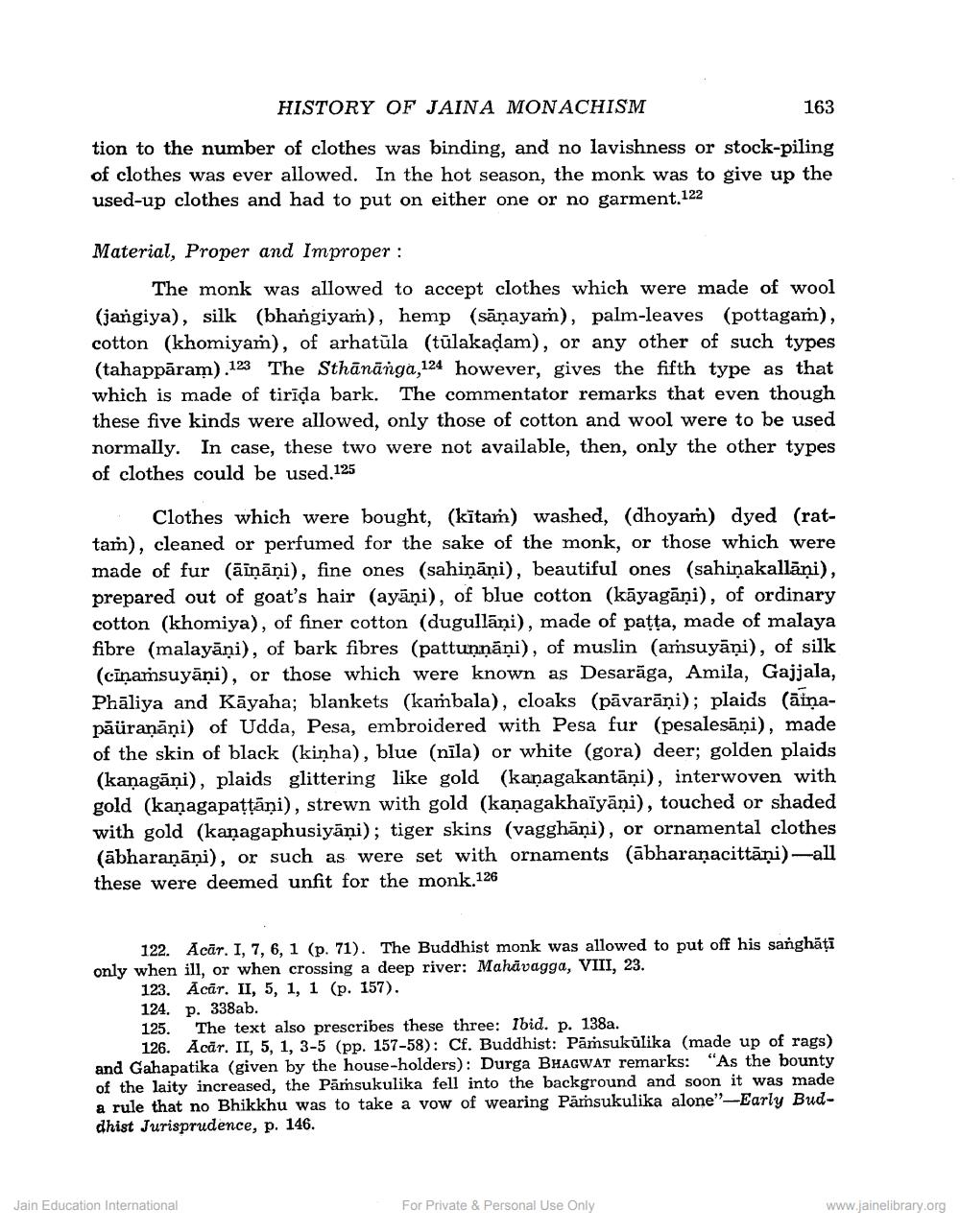________________
HISTORY OF JAINA MONACHISM
163 tion to the number of clothes was binding, and no lavishness or stock-piling of clothes was ever allowed. In the hot season, the monk was to give up the used-up clothes and had to put on either one or no garment.122
Material, Proper and Improper :
The monk was allowed to accept clothes which were made of wool (jangiya), silk (bhangiyam), hemp (sāņayam), palm-leaves (pottagam), cotton (khomiyam), of arhatula (tūlakadam), or any other of such types (tahappāram).123 The Sthānānga, 124 however, gives the fifth type as that which is made of tirida bark. The commentator remarks that even though these five kinds were allowed, only those of cotton and wool were to be used normally. In case, these two were not available, then, only the other types of clothes could be used.125
Clothes which were bought, (kītaṁ) washed, (dhoyam) dyed (rattam), cleaned or perfumed for the sake of the monk, or those which were made of fur (āiņāņi), fine ones (sahiņāņi), beautiful ones (sahiņakallāni), prepared out of goat's hair (ayāņi), of blue cotton (kāyagāņi), of ordinary cotton (khomiya), of finer cotton (dugullāņi), made of patta, made of malaya fibre (malayāņi), of bark fibres (pattunnāņi), of muslin (amsuyāņi), of silk (cīņamsuyäni), or those which were known as Desarāga, Amila, Gajjala, Phāliya and Kāyaha; blankets (kambala), cloaks (pāvarāņi); plaids (āiņapāüraņāņi) of Udda, Pesa, embroidered with Pesa fur (pesalesāņi), made of the skin of black (kinha), blue (nīla) or white (gora) deer; golden plaids (kaņagāni), plaids glittering like gold (kanagakantāni), interwoven with gold (kaņagapatřāņi), strewn with gold (kaņagakhaïyāni), touched or shaded with gold (kanagaphusiyāņi); tiger skins (vagghāni), or ornamental clothes (ābharaṇāņi), or such as were set with ornaments (abharanacittani)—all these were deemed unfit for the monk.126
122. Acar. I, 7, 6, 1 (p. 71). The Buddhist monk was allowed to put off his sanghăți only when ill, or when crossing a deep river: Mahāvagga, VIII, 23.
123. Acār. II, 5, 1, 1 (p. 157). 124. p. 338ab. 125. The text also prescribes these three: Ibid. p. 138a.
126. Acar. II, 5, 1, 3-5 (pp. 157-58): Cf. Buddhist: Pāmsukūlika (made up of rags) and Gahapatika (given by the house-holders): Durga BHAGWAT remarks: "As the bounty of the laity increased, the Pārsukulika fell into the background and soon it was made a rule that no Bhikkhu was to take a vow of wearing Pärsukulika alone"-Early Buddhist Jurisprudence, p. 146.
Jain Education International
For Private & Personal Use Only
www.jainelibrary.org




